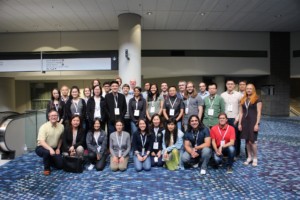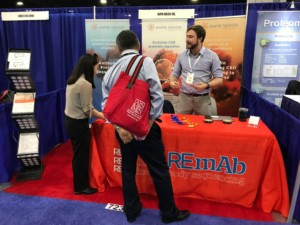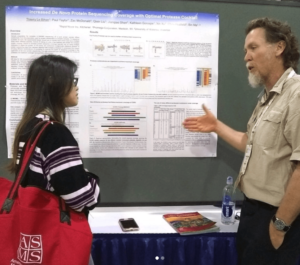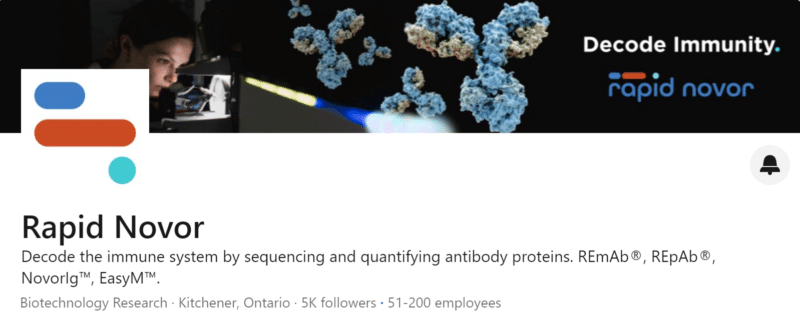This year’s American Society for Mass Spectrometry (ASMS) conference took place in Atlanta, Georgia, the peach state of the US. Our Proteomics Specialist, Kathleen Gorospe, brought back home some delicious peach cookies, for which we have no pictures because they were devoured instantly. The ASMS conference was very fruitful indeed. There was a total of 384 oral presentations, more than 2700 poster presentations, in addition to training courses, and nightly workshops on important topics for the Mass Spectrometry (MS) community.

Kathleen (front row, middle) at the Bioinformatics of Protein Identification course at ASMS 2019.
Kathleen attended one of the offered training courses: Bioinformatics of Protein Identification. The course presented an overview of the commonly used bioinformatic tools in shotgun liquid chromatography tandem mass spectrometry (LC-MS/MS) datasets. The course was run by Drs. Tabb, Nesvizhskii, and Bandeira of Stellenbosch University, University of Michigan and University of California, respectively. Dr. Bandeira also guided one of the nightly workshops attended by one of our scientists, Dr. Thierry Le Bihan. The workshop discussed data analysis and data sharing as well as what constitutes a biological replicate, an important discussion that must be maintained by the scientific community; though no consensus was reached, the use of more samples, appropriate experimental design and across-the-board standardization were extensively debated.

Our engaging sales executive, Clayton, discussing why our REmAb protein sequencing platform can re-define the way researchers work with antibodies.
We presented two posters at the conference showcasing work by our scientists, Drs. Thierry Le Bihan, and Zac McDonald and Bin Ma, respectively. Thierry and Kathleen presented each poster. This was Kathleen’s first poster presentation and she did wonderfully! Thierry’s poster discussed ways to statistically increase the accuracy and achieve full sequence coverage of protein sequencing by digests with different proteases and MS high collision-induced dissociation (HCD) fragmentation. Zac and Bin’s poster (presented by Kathleen) showed that protein sequencing is as accurate as DNA sequencing, and showed instances in which protein sequencing was able to fill in gaps where DNA sequencing failed. To request pdf versions of these posters, please e-mail us at info@rapidnovor.com. We were happy to see that there was great interest at both our posters and our booth. Thank you to all who stopped by!
We also saw some great work at ASMS 2019. Many groups presented ways to increase coverage in proteomics. Trypsin is currently the gold standard for proteomics because this protease is a relatively efficient enzyme for cleaving proteins into many fragments. However, because trypsin cleaves specifically at the C-terminus of both lysine (Lys) and arginine (Arg), trypsin digestions may yield fragments that are either too small or too big; the use of other proteases is often needed to increase protein coverage in regions where trypsin typically does not perform well, especially for determining the sequence of antibody (Ab) variable regions such as the complementarity determining region (CDR). The Shimadzu corporation proposed a new twist to a limited trypsin proteolysis to target and enrich Ab CDRs. Another group, the Broadbelt lab from the University of Texas, presented three posters, all showcasing the use of carbamylation reactions and LysC digestions to replace and/or complement trypsin-based proteomics. They exploited this methodology alongside other experimental approaches such as aminoethylation and guanidination modification to generate alternative cleaving sites for LysC.

Our senior research scientist, Thierry, explaining how to increase your sequencing coverage using a combination of proteases.
The use of different enzymes and protein chemistry modifications continues to be immensely helpful for interpreting protein spectra. This includes the use of tools for elucidating post-translation modifications (PTMs) important for antibody function such as glycosylation. O-linked glycosylation is particularly important to characterize as it does not have an established sequence motif, varies greatly in structure and concentrates in serine (Ser) and threonine (Thr) clusters. Standard proteomic approaches with trypsin result in peptides rich in diverse o-linked glycosylation regions that make proteomic bioinformatics a labour-intensive endeavour. To facilitate efforts tracking PTMs, Genovis presented work where they introduced OgpA – an enzyme from gut commensal bacteria that can cleave at the N-terminus of o-linked glycosylated Ser and Thr residues. This enzyme will prove very useful in future studies of Ab glycosylation patterns. Some other Ab glycosylation-related research included that of the Gygi group from Harvard in collaboration with Cell Signaling Technologies regarding antibodies used to enrich for o-linked glycosylation peptides. They generated a peptide library with different combinations of o-linked glycosylated Ser or Thr residues. They immunized rabbits with these o-linked glycosylated peptide libraries to generate polyclonal Abs, which they then selected for further rabbit monoclonal Ab (mAb) development. Downstream mAbs were used to enrich for o-linked glycosylated tryptic peptides from harvested HeLa cells. The tryptic peptides were screened for the presence of post-translation modifications (PTMs) using LC-MS/MS in a Fusion Lumos Orbitrap. They were able to show that their mAbs have high specificity toward site-specific o-linked PTMs.
Also from the Boston area, Dr. Ioannis Papayannopoulus, author of a fundamental review and widely read 1995 paper on interpretation of CID MS/MS spectra, presented work on characterizing acidic species affecting mAbs during cell line passaging. It remains important to characterize factors that affect Abs at the protein level as these are factors that cannot be properly characterized through DNA sequencing. In terms of instruments, Agilent Technologies, Bruker and Thermo Scientific all showcased strong mass spectrometers. Thermo largely dominates this market, but based on features and stats, Bruker’s timsTOF instrument might soon introduce some healthy competition. Finally, we also saw amazing uses of MS, outside antibody-related work, including a poster by the MacCoss group in Washington, presenting work that utilized our Novor algorithm as a tool to de novo derive the sequence of unknown proteins from already acquired tandem mass spectra and validate the suitability of protein sequence databases. We were happy to see that they found Novor was “a fast and accurate automated de novo sequencing software”. Other groups employed MS for food testing and art composition analysis. We thought the MS-based beer quality testing by Shimadzu corporation was particularly compelling. Overall, we found that the conference was full of exciting work and we are looking forward to next year’s ASMS.
References
Iwamoto, N., Yonezawa, A., Matsubara, K., and Shimada, T. Regulated LC-MS Bioanalysis of Monoclonal Antibodies in Human Serum for Inflammatory Immune Disease Management Using Novel Fab-Selective nSMOL Chemistry. Poster presented at the 67th American Society for Mass Spectrometry (ASMS) conference. 2019 June 2nd – 6th. Atlanta, Georgia.
Lanzilotti, M. B., and Brodbelt, J. S. Enhancing Middle-Down Proteomics by Limited Carbamylation of Proteins and Lys-C Digestion. Poster presented at the 67th American Society for Mass Spectrometry (ASMS) conference. 2019 June 2nd – 6th. Atlanta, Georgia.
Helms, A., and Brodbelt, J. S. Impact of Charge Sites on Fragmentation of Peptides and Proteins: Carbamylation and Guanidination. Poster presented at the 67th American Society for Mass Spectrometry (ASMS) conference. 2019 June 2nd – 6th. Atlanta, Georgia.
Dunham, S., and Brodbelt, J. S. Cysteine-Selective Middle-Down Proteomics with Ultraviolet Photodissociation. Poster presented at the 67th American Society for Mass Spectrometry (ASMS) conference. 2019 June 2nd – 6th. Atlanta, Georgia.
Nägeli, A., Widdowson, P. J., Nordgren, M., Buchanan, T., Lood, R., Leo, F., Nyhlén, H., Sjögren, J., Olsson, F. (Genovis poster). Analysis of O-glycosylated Biopharmaceuticals Using an O-glycan Dependent Endoprotease and LC-MS. Poster presented at the 67th American Society for Mass Spectrometry (ASMS) conference. 2019 June 2nd – 6th. Atlanta, Georgia.
Fry, M. D., Najjar, R., Zhu, Y., Ren, J. M., Schweppe, D. K., Gygi, S. P., Stokes, M. P., and Lee, K. A. Novel Rabbit Monoclonal Antibodies for Profiling of Ser/Thr O-GlcNAc Modified Proteins. Poster presented at the 67th American Society for Mass Spectrometry (ASMS) conference. 2019 June 2nd – 6th. Atlanta, Georgia.
Papayannopoulos, I. A., and Renn-Bingham, S. Mass Spectrometric Characterization of Acidic Species Generated in Cell Culture and Stability Studies of Monoclonal Antibodies. Article presented at the 67th American Society for Mass Spectrometry (ASMS) conference. 2019 June 2nd – 6th. Atlanta, Georgia.
Johnson, R. S., Nunn, B. L., Searle, B. C., Phillips, M., Amemiya, C. T., Heck, M., and MacCoss, M. J. Assessing Protein Sequence Database Suitability Using de Novo Sequencing. Poster presented at the 67th American Society for Mass Spectrometry (ASMS) conference. 2019 June 2nd – 6th. Atlanta, Georgia.
Talk to Our Scientists.
We Have Sequenced 10,000+ Antibodies and We Are Eager to Help You.
Through next generation protein sequencing, Rapid Novor enables reliable discovery and development of novel reagents, diagnostics, and therapeutics. Thanks to our Next Generation Protein Sequencing and antibody discovery services, researchers have furthered thousands of projects, patented antibody therapeutics, and developed the first recombinant polyclonal antibody diagnostics.
Talk to Our Scientists.
We Have Sequenced 9000+ Antibodies and We Are Eager to Help You.
Through next generation protein sequencing, Rapid Novor enables timely and reliable discovery and development of novel reagents, diagnostics, and therapeutics. Thanks to our Next Generation Protein Sequencing and antibody discovery services, researchers have furthered thousands of projects, patented antibody therapeutics, and ran the first recombinant polyclonal antibody diagnostics



